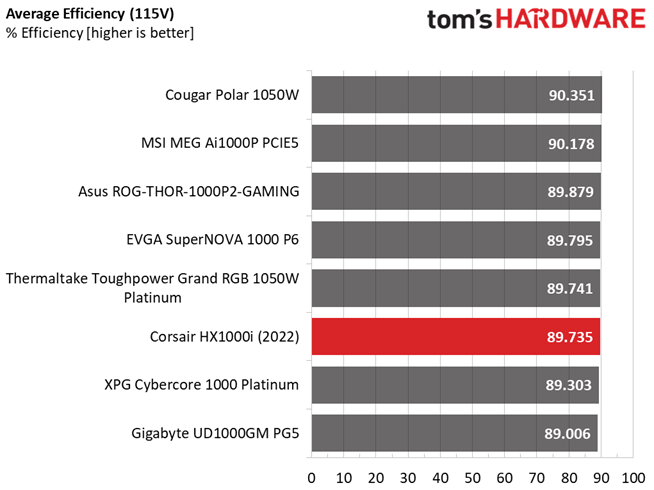Why you can trust Tom's Hardware
Performance Rating
The performance difference is not huge with other similar spec PSUs, but we expected the HX1000i to perform even better, given its cutting-edge design and top-notch build quality.
Noise Rating
The graph below depicts the cooling fan's average noise over the PSU's operating range, with an ambient temperature between 30 to 32 degrees Celsius (86 to 89.6 degrees Fahrenheit).
The average noise output is low.
Efficiency Rating
The following graph shows the PSU's average efficiency throughout its operating range with an ambient temperature close to 30 degrees Celsius.
Average efficiency is high enough, but there is room for improvement.
Power Factor Rating
The following graphs show the PSU's average power factor reading throughout its operating range with an ambient temperature close to 30 degrees Celsius and 115V/230V voltage input.


The APFC converter does a great job!
Get Tom's Hardware's best news and in-depth reviews, straight to your inbox.
MORE: Best Power Supplies
MORE: How We Test Power Supplies
MORE: All Power Supply Content
Current page: Performance, Noise, Efficiency and Power Factor
Prev Page Transient Response Tests, Timing Tests, Ripple Measurements and EMC Pre-Compliance Testing Next Page Bottom Line
Aris Mpitziopoulos is a contributing editor at Tom's Hardware, covering PSUs.
-
Co BIY Another nicely done review. Seems lots of people will need a 1000 Watt supply now.Reply
This is the first time I've heard about PCIe 5.0 having anything to do with the power supply ?
Maybe in the next review you could explain this. -
jkflipflop98 I picked up a 1kw cooler master PSU about 10 years ago or so. It's still going strong.Reply -
escksu ReplyCo BIY said:Another nicely done review. Seems lots of people will need a 1000 Watt supply now.
This is the first time I've heard about PCIe 5.0 having anything to do with the power supply ?
Maybe in the next review you could explain this.
Its not really about the PCIE 5.0 slot but the power connector for graphics card. New graphics cards are supposed to utilise the so-called "PCIE 5.0 16pin power connector" (again, nothing to do with PCIE 5.0 slot).
Eg. the RTX4090 uses PCIE 5.0 16 pin power connector but its actually a PCIE 4.0 16x card.
You do not need any special PSU in order to utlise the PCIE 5.0 slot on your board. Currently there are no PCIE 5.0 devices other than SSD.


